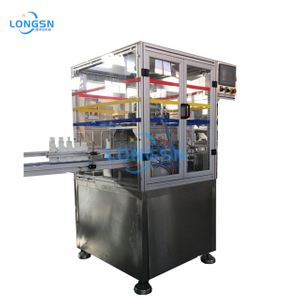Plastic bottles are everywhere — from water and soft drinks to cleaning products and cooking oils. With billions of bottles produced and discarded each year, recycling has become a critical part of the global effort to reduce plastic waste and protect the environment. While many people are familiar with the process of sorting and melting plastic, fewer understand the detailed machinery that plays essential roles in recycling systems. One such machine is the bottle neck cutting machine, a specialized device that helps prepare plastic bottles for effective and efficient recycling.
This article explores in detail the function, importance, and benefits of bottle neck cutting machines in the context of plastic bottle recycling. Whether you are a recycling industry professional or simply someone curious about how recycling works, this article will help you understand the indispensable role of this equipment in the circular economy.
Understanding the Recycling Process for Plastic Bottles
Before diving into the specifics of bottle neck cutting machines, it’s useful to understand the general process of plastic bottle recycling:
Collection and Sorting: Bottles are collected from households, businesses, and public bins. They are then sorted by type of plastic, usually polyethylene terephthalate (PET) or high-density polyethylene (HDPE).
Washing: Bottles are thoroughly washed to remove dirt, labels, adhesives, and leftover liquids.
Shredding: Clean bottles are fed into shredders that break them into smaller plastic flakes.
Separation: The flakes are separated based on density, often using water. This helps remove caps and labels made from different materials.
Melting and Reforming: The clean flakes are melted down and reformed into plastic pellets, which are used to make new products.
While this seems straightforward, real-world recycling is filled with technical challenges. One major issue is the bottle neck and cap, which are often made from materials different from the main body of the bottle. If these parts are not properly handled, they can reduce the quality of the recycled plastic or even damage processing equipment. This is where the bottle neck cutting machine becomes vital.
What Is a Bottle Neck Cutting Machine?
A bottle neck cutting machine is a piece of industrial equipment specifically designed to remove the upper portion of a plastic bottle, including the neck and screw-threaded cap area. This part of the bottle is usually more rigid and thicker than the rest of the container, and often made of a different polymer.
By cleanly cutting off the bottle neck, the machine ensures that the bottle is more uniform in material and structure for downstream recycling processes. These machines are typically automatic and can process hundreds to thousands of bottles per hour, making them ideal for use in large-scale recycling plants or bottle production facilities.
Why Is the Bottle Neck Problematic in Recycling?
There are several reasons why the bottle neck poses a problem in plastic recycling:
Material Differences: The neck and cap are often made of polypropylene (PP) or high-density polyethylene (HDPE), while the bottle body is commonly PET. Mixing these materials can contaminate the recycling stream.
Shape and Thickness: The bottle neck is thicker and harder than the rest of the bottle. This makes shredding and melting more difficult, increasing wear on blades and affecting the consistency of the output flakes.
Caps and Seals: Many caps include rubber or silicone seals, metal springs (in pump dispensers), or additional lining materials, which complicate recycling and must be removed.
Label Residue: The area near the neck often holds stubborn adhesive labels or tamper-proof bands that are hard to remove with regular washing.
By removing the neck area altogether, bottle neck cutting machines improve the quality and purity of the recycled plastic.
How Does a Bottle Neck Cutting Machine Work?
A bottle neck cutting machine operates through the following key steps:
Bottle Feeding: Bottles are automatically or manually placed onto the machine’s conveyor or feeding mechanism.
Positioning: The machine uses guides or sensors to align each bottle correctly for cutting.
Rotational Cutting Mechanism: A cutting blade, often spinning or rotary in nature, slices through the neck of the bottle at a predefined height. This ensures consistency and prevents jagged edges.
Collection of Cut-Off Parts: The machine separates the cut neck and body into different bins. This allows for easier material sorting downstream.
Output: The trimmed bottle body moves on to the next stage, such as shredding, while the neck portion may be separately processed or discarded depending on the recycling goals.
Modern machines are controlled using a PLC system (Programmable Logic Controller), often paired with a touch-screen interface. Operators can adjust parameters such as cutting height and speed to suit different bottle sizes and types.
Benefits of Using a Bottle Neck Cutting Machine in Recycling
The use of bottle neck cutting machines offers multiple advantages in recycling facilities:
1. Improved Material Purity
By separating different plastics at an early stage, recycling plants can reduce contamination and produce higher-quality recycled pellets. This improves the resale value of the material and reduces waste.
2. Increased Equipment Lifespan
Shredders and grinders wear out more slowly when they are not forced to cut through thick bottle necks. This reduces maintenance costs and downtime.
3. Enhanced Efficiency
Machines can process hundreds or even thousands of bottles per hour. This automation drastically speeds up the recycling process compared to manual separation or cutting.
4. Reduced Labor Cost
Automating the neck cutting process eliminates the need for manual workers to trim bottles with blades or scissors, which is slow and unsafe.
5. Higher Output Quality
Recyclers can achieve more consistent and uniform plastic flakes by removing irregular parts of the bottle. This is especially important for applications where the recycled plastic is reused in food-grade or medical products.
Applications Beyond Recycling
Interestingly, bottle neck cutting machines are not used only in recycling. They also have important roles in:
Bottle manufacturing plants: To finish bottles that come out of molds with uneven necks.
Quality control lines: To remove defectively shaped necks before packaging.
Chemical packaging: To cut necks to standard heights for specific closures or seals.
These additional uses make bottle neck cutting machines a valuable asset in various stages of the plastic product lifecycle.
Features of a Modern Bottle Neck Cutting Machine
If you're considering investing in or understanding industrial recycling equipment, here are some features that modern bottle neck cutting machines typically offer:
Adjustable Cutting Height: To handle various bottle sizes.
Compatibility with Multiple Materials: PET, HDPE, PP, and PVC.
Rotary or Circular Blades: For clean, burr-free cuts.
High-Speed Operation: 800–1100 bottles per hour or more.
Compact Structure: Designed to fit easily into existing production lines.
Durable Build: Made of stainless steel or aluminum to resist corrosion.
User-Friendly Interface: Usually with touchscreen and programmable settings.
Safety Features: Emergency stops, cover guards, and automatic error detection.
Environmental Impact
By improving the efficiency of plastic recycling, bottle neck cutting machines also contribute to broader environmental goals. Here’s how:
Reduced Landfill Waste: More plastic gets recycled correctly, rather than being dumped due to contamination.
Lower Carbon Footprint: Efficient machines consume less energy than older or manual processes.
Support for Circular Economy: Clean separation of materials supports reuse and remanufacturing, reducing reliance on virgin plastic.
Waste Diversion: By separating non-recyclable components early, facilities can divert waste into proper waste-to-energy or alternative material streams.
Conclusion
The bottle neck cutting machine may not be the most well-known tool in the recycling world, but it plays a vital and often underestimated role. By improving the purity, consistency, and efficiency of plastic bottle recycling, this machine supports a cleaner, more sustainable future. It enables recycling facilities to meet higher quality standards while reducing energy use, labor, and maintenance costs.
As global concern over plastic waste continues to grow, the demand for intelligent, efficient recycling technology like the bottle neck cutting machine will only increase. From enhancing the economics of recycling to supporting environmental responsibility, this machine truly cuts through the problem — quite literally — at the neck.
Whether you run a recycling plant, manufacture plastic containers, or are simply interested in the hidden heroes of sustainability, the bottle neck cutting machine deserves your attention.

 English
English









